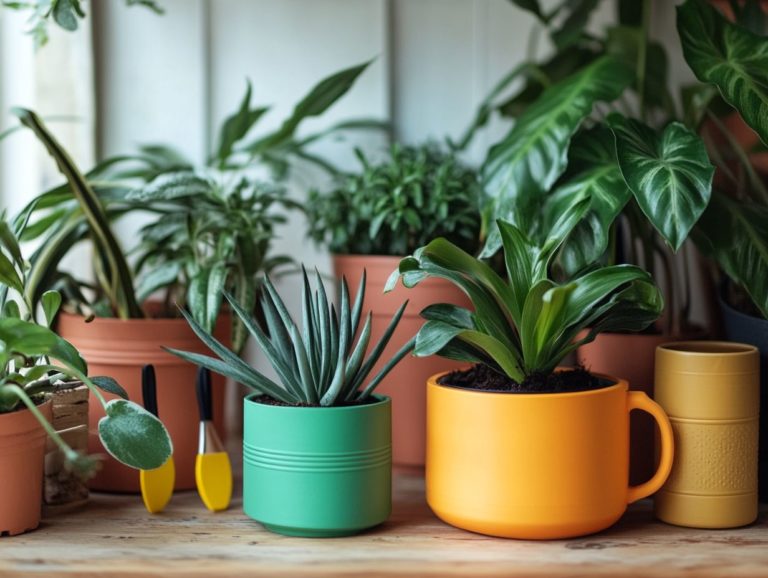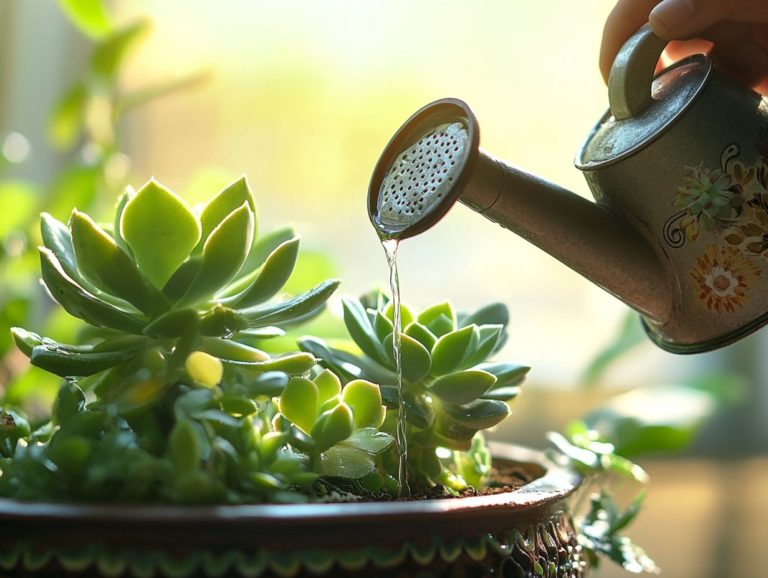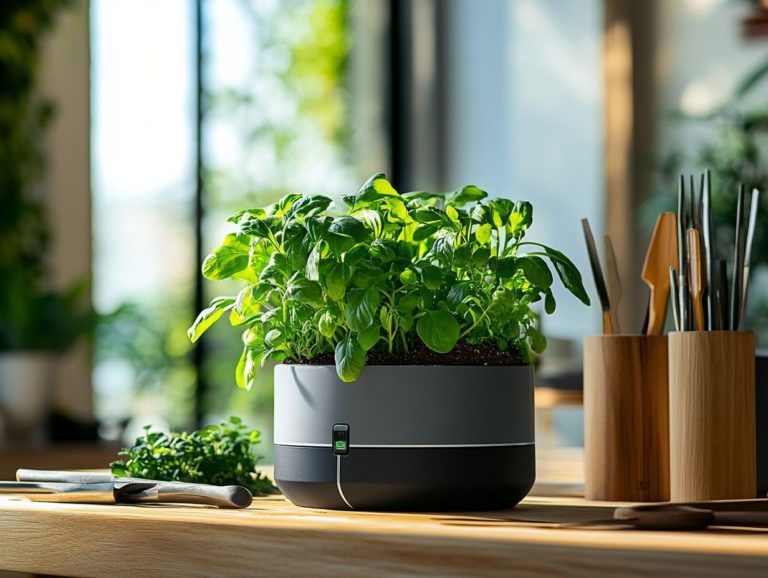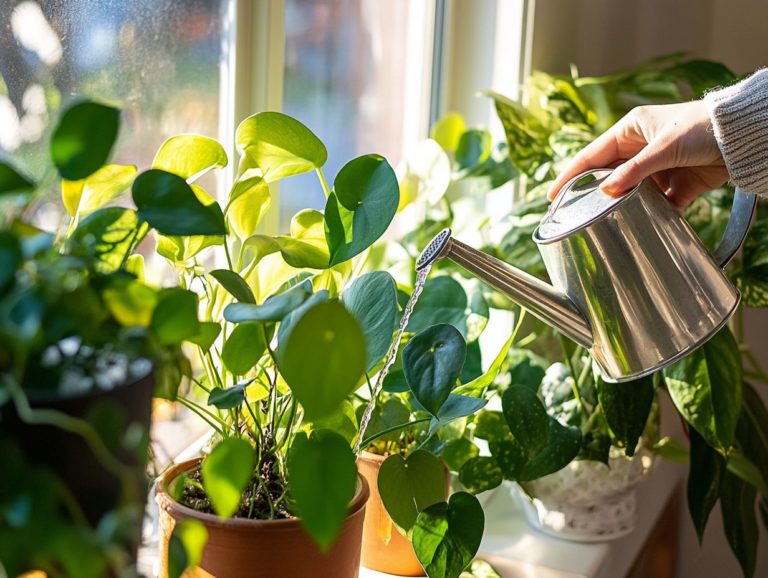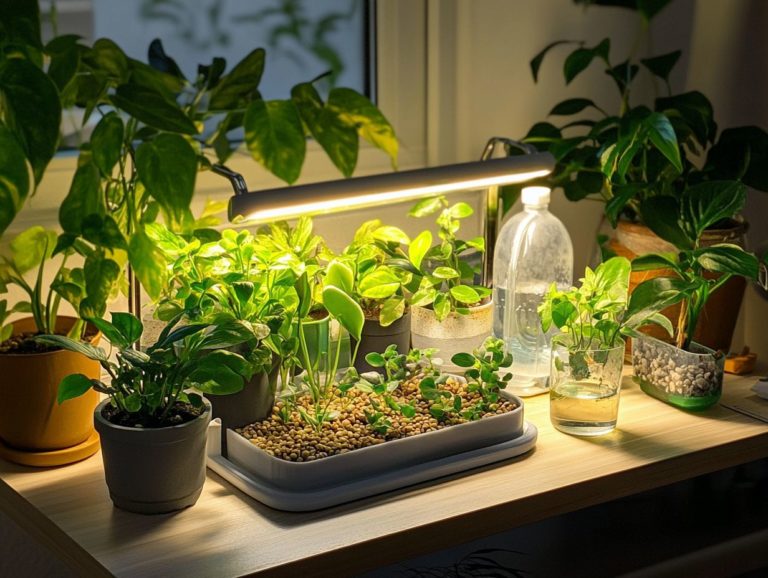Choosing the Right Water for Indoor Plants
Water is vital for the health of your indoor plants, but not all water is the same.
Understanding your plants’ watering needs is essential for their growth. Let s uncover the secrets to watering your plants like a pro!
You’ll learn to spot the signs of overwatering and underwatering. Plus, find practical tips for choosing the best water for your plants.
Contents
Key Takeaways:
- Understand your plant’s water needs by considering humidity, soil type, and plant species.
- Choose the right water: tap water for hardy plants, filtered for sensitive ones, and distilled for carnivorous plants.
- Use proper watering techniques and regularly check for signs of water stress to keep your plants healthy.
Understanding Water Needs for Indoor Plants
Each plant species has unique water needs influenced by humidity, potting medium, and soil drainage.
Overwatering or underwatering can cause serious problems, such as root rot or wilting leaves. It s important to create a watering schedule that’s right for your specific plants, including peace lilies, cacti, and succulents.
This overview will equip you with the knowledge to check soil moisture and avoid common pitfalls.
Factors that Affect Watering Frequency
Many factors determine how often you should water your indoor plants. These include humidity levels, light exposure, and the type of potting medium you choose.
Recognizing these elements helps you cultivate a thriving indoor garden tailored to each plant. For example, cacti and succulents prefer dry conditions, while peace lilies need consistently moist soil.
Light exposure also affects how quickly the soil dries. Understanding each plant’s needs in relation to its environment promotes optimal health and growth.
Types of Water for Indoor Plants
The type of water you choose plays a significant role in your plants’ health. Options like tap water, distilled water, and rainwater have unique benefits and drawbacks, mostly based on their mineral content.
Choosing wisely can make all the difference for your green companions.
Tap Water vs. Filtered Water vs. Distilled Water
Choosing between tap, filtered, and distilled water is crucial for your plants. Each type has characteristics like chlorine and mineral content that can impact how well they absorb water.
For instance, tap water is convenient but can harm sensitive plants like peace lilies. Filtered water removes many harmful substances, while distilled water is pure and great for delicate varieties.
Test your water quality with simple kits to find the best option for your plants.
Take these insights and give your indoor garden the care it deserves. Start today for thriving plants tomorrow!
Watering Techniques for Indoor Plants
Implementing effective watering techniques for your indoor plants is essential for fostering healthy growth and preventing problems like root rot and overwatering. You have a variety of methods at your disposal, including:
- Moisture meter: A tool that measures how wet the soil is.
- Watering can: For precise control.
- Self-watering systems: These help maintain optimal moisture levels effortlessly.
Each approach has its benefits, ensuring your plants thrive with the care they deserve.
Proper Watering Methods for Different Types of Plants
Indoor plants need specific watering methods to thrive. Techniques vary significantly between species such as cacti, succulents, and peace lilies, each with unique moisture needs and root structures.
For example, cacti and succulents those resilient wonders that store water in their leaves and stems flourish with infrequent watering. Soak them deeply and let them dry out entirely between sessions.
In contrast, peace lilies prefer their soil to remain consistently moist. They signal distress with dropped leaves when they re not getting enough water.
To determine when it s time to water, simply insert your finger about an inch deep into the soil. If it feels dry, it s time to give them a drink.
Seasonal changes require you to adjust your watering routine. Indoor heating can dry out the air more quickly in winter, while the summer heat may require you to check on them more frequently.
Signs of Overwatering and Underwatering
Recognizing the signs of overwatering and underwatering is crucial for sustaining the health of your indoor plants. Symptoms include:
- Wilting leaves
- Yellowing foliage
- Root rot
These can indicate that your watering practices may be threatening the vitality of your plants. By understanding these indicators, you can ensure your green companions thrive in their environment.
Identifying and Addressing Watering Issues
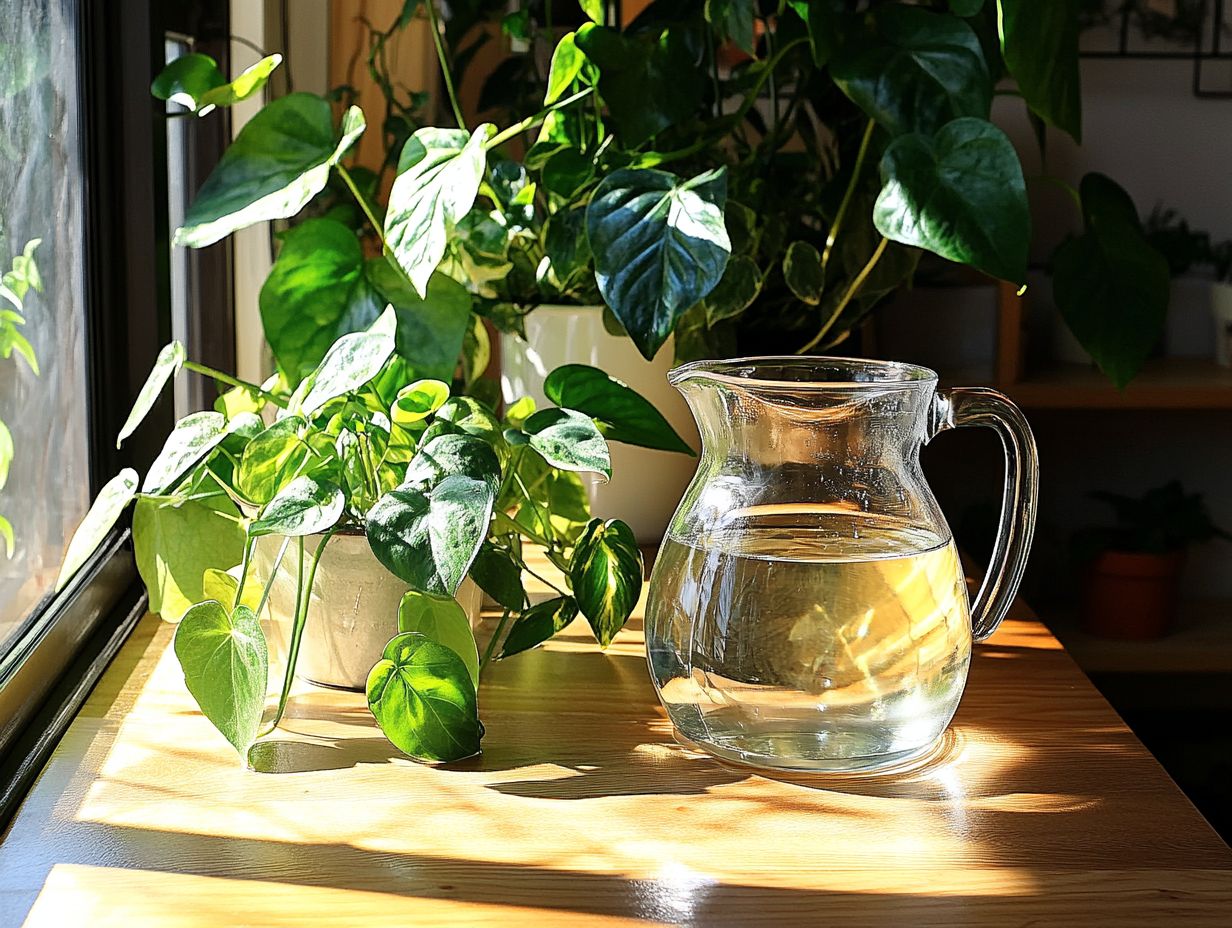
Identifying and addressing watering issues in your indoor plants is crucial for their overall health. Timely recognition of signs of overwatering like root rot or underwatering can lead to effective solutions and thriving plants.
Pay close attention to the leaves, soil texture, and general growth patterns. This will help you discern whether your plant is thirsty or has had its fill. For example:
- Yellowing leaves: May indicate too much moisture.
- Wilting leaves: Can signal dehydration.
Act now! Adjust your care practices to keep your plants thriving by ensuring proper drainage and modifying your watering frequency with the changing seasons.
Utilizing moisture meters can give you a precise understanding of soil hydration levels, fostering optimal growth across various plant types.
Tips for Choosing the Right Water for Indoor Plants
Choosing the right water is absolutely vital for your plants’ health! Several key tips can help you select the best option, considering:
- Water quality
- Potential salt buildup
- Mineral content
All of these factors can significantly influence your plants’ growth.
Considerations for Different Plant Species
When selecting water for various plant species, consider their individual needs and preferences. Factors such as soil type, potting medium, and environmental conditions profoundly affect the most suitable water type for each plant.
Take the peace lily, for example; it flourishes in consistently moist soil, demanding more frequent watering to maintain its health and vibrant blooms. For optimal care, consider exploring the best watering techniques for indoor plants. On the other hand, cacti and succulents, adapted to arid conditions, have much lower water requirements and often thrive with infrequent soaking.
Adjusting your watering frequency accordingly is essential. Using a well-draining potting mix can help you prevent root rot in moisture-loving plants while providing the drainage necessary for drought-resistant varieties.
Keep an eye on humidity levels and seasonal changes as these factors can significantly influence the water needs of each specific species.
How to Test Water Quality for Plants
Testing water quality for your plants is essential for maintaining their health. You have several methods at your disposal. From using moisture meters to conducting simple at-home tests for pH levels and mineral content, you can ensure your plants thrive.
By regularly evaluating water quality, you can spot potential issues early. This includes signs of overwatering which could lead to root rot and other complications. It’s crucial to recognize how contaminants like chlorine or excess salts can adversely impact both soil health and plant growth.
A straightforward pH test can reveal whether the water is too acidic or alkaline. Knowing whether your water is too acidic or alkaline can make a real difference in how well your plants absorb nutrients.
Monitoring mineral content is important because it guarantees that your plants receive the important nutrients they need to flourish. This ultimately cultivates a more vibrant and lush garden environment.
Check out this helpful video for more on water quality!
Frequently Asked Questions
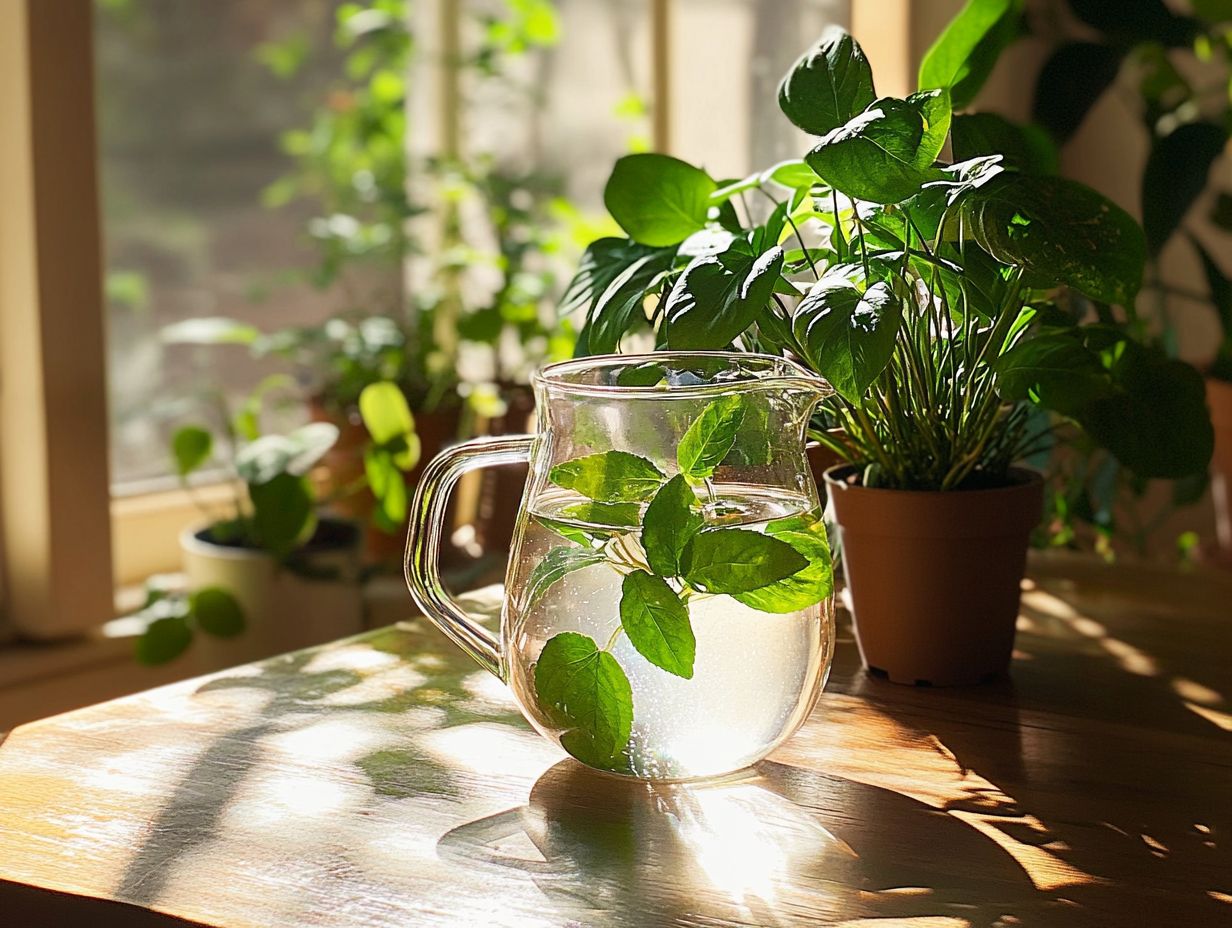
What types of water are best for indoor plants?
The best types of water for indoor plants are filtered, rain, and distilled water. These types are free from harmful chemicals and minerals that can damage your plants.
Can I use tap water for my indoor plants?
Tap water can be used for indoor plants, but it may contain high levels of chlorine, fluoride, and other minerals that can harm your plants. It’s best to use filtered or distilled water instead.
Why is rainwater good for indoor plants?
Rainwater is the most natural and pure form of water for your plants. It is free from any chemicals and contains beneficial minerals that can help your plants grow. Plus, it’s free and easy to collect!
What is the difference between filtered and distilled water?
Filtered water has gone through a filtration process to remove impurities and chemicals. Meanwhile, distilled water has been boiled and condensed to remove all minerals and contaminants. Both types of water are safe for indoor plants, but distilled water is the purest form.
Can I use bottled water for my indoor plants?
Bottled water can be used for indoor plants, but it can be expensive and not necessarily better than tap water. If you choose to use bottled water, make sure it is purified or distilled and free from any added minerals or chemicals.
Should I let my water sit out overnight before watering my plants?
Letting your water sit out overnight can help reduce the amount of chlorine and other chemicals in tap water. This can be beneficial for your plants, but it is not necessary. Using filtered or distilled water is a better option for indoor plants.
Start testing your water today to give your plants the best chance to thrive!


